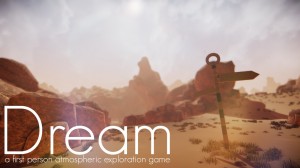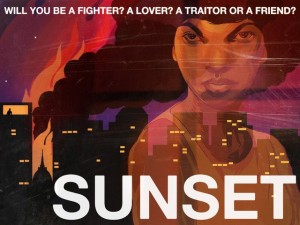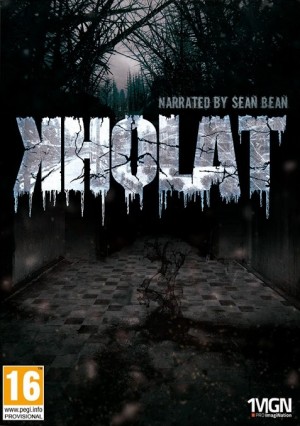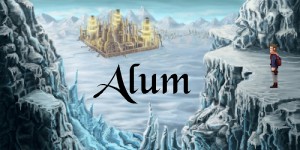Review for Dream

Ordinarily, I’d open with a bit of frivolity and tangentially-related fluff before transitioning into my review proper, but I can’t really think of any cute way to segue into this: Dream is a mess. That’s a shame because, all things being equal, it could have at least been an interesting mess, but as it stands, it’s a bit of a mess in essentially every way that matters, or at least every way that should matter.
Before we go any further, I want to take a moment to acknowledge the elephant in the room, which is that Dream spent roughly two years gestating in the gaming incubator known as Steam Early Access. For anyone unfamiliar with Early Access, it’s essentially a place where alpha versions of “sandbox”-style games (think survival/simulation/strategy) go to die. It seems an unlikely and unconventional choice for a nascent adventure game, which is typically a rather contained and finite experience. That doesn’t mean it can’t work for an adventure, but Dream clearly won’t be the game to defy that expectation. I could spend a while debating how the content of the game might have been affected for better or worse by the Early Access process, but I’ll sidestep that rabbit-hole and just stick to the technical side of it. Along with a few actual crashes, I ran into the occasional bug which blocked my progress outright, though most of these were resolved by restarting the game or resetting a puzzle. Overall, the majority of the glitches were fairly innocuous and fell into the “annoying” rather than the “game-breaking” category, but they were consistent and distracting enough that the whole experience had a very unpolished feel.
It doesn’t take a fantastic leap of imagination (or any, for that matter) to suss out Dream’s premise, so suffice to say the game would best be described as a surreal exploration adventure. Unfortunately, while Dream admirably tries to find some middle-ground between puzzle-solving and pure exploration, neither of these experiences is particularly satisfying and, taken together, the whole unfortunately doesn’t add up to more than the sum of its parts.
After a brief prologue in the real world, once you guide your unseen protagonist to bed, the rest of the game is a literal exploration of a dream, or rather, a series of dreams. The initial dream acts as a sort of hub from which you can access the other dreams through portals. There are three main dreams, each of which has additional portals to a couple of side dreams. You can also “wake up” at any time, which will send you back to your bedroom, but after you’ve initially explored your house in the opening, there’s nothing else to discover or do in the waking world, so there’s really no point. (This is also where you have to resume the game every time you quit, which makes continuing a little tedious). There could have been some Inception-like, dream-within-a-dream dynamics at play, but there’s not really any meaningful interplay or connection among the dreams and side dreams and real world – with one exception – other than as a means of egress, which feels like a profoundly missed opportunity. (Technically, the dream hub acts as a trophy case for some of the collectibles you find in the other dreams, but that’s small consolation.)
The obvious advantage of setting a game inside a dream is that it basically gives you carte blanche to do whatever the hell you want so far as environments or puzzle design are concerned. As such, maybe I went in with unrealistic expectations, but one of the most disappointing elements of the game is that the dreams settings are so… ordinary. That’s not to say that there aren’t a few interesting environments mixed in (such as an Escher-like side dream), but the dreams are largely a mix of rather pedestrian settings with a few bits of abstract decoration tossed in (e.g., a stack of televisions in the desert, aggressive plumbing fixtures in an office building, or the obligatory floating rocks and Moai in the meadow).
This, in itself, wouldn’t be a problem, but a significant portion of Dream consists of pure exploration (i.e., wandering around), and the key to making this an effective gameplay device is constructing an environment that will hold the gamer’s interest, either visually or narratively. Sadly, Dream does neither of these consistently. The second main dream is an office building with at least a dozen or more rooms, but aside from a handful of areas with something to see or interact with, the bulk of the dream is basically just a series of empty hallways and offices filled with wholly unremarkable desks and filing cabinets.
And therein lies the problem with the exploration portion of the game: the main dreams are relatively expansive, but they’re essentially a collection of generic corridors or rooms connecting a few points of interest. The side dreams do a slightly better job, but they benefit from being relatively small and contained experiences. Once this realization sunk in, about halfway through the first main dream, I was rather done with the exploration bit and spent the majority of the game literally running through each level, looking for the gaming bits.
The gaming bits, as such, consist of traditional adventure game puzzles tossed with a fair bit of scavenger hunting. The puzzles are mostly what you expect to find in a first-person adventure descended from the Myst genome, which is to say deciphering and manipulating some bits of obtuse machinery or architecture, plus some slider puzzles and similar faff. There’s nothing here that will stump any adventure veteran. Most of the puzzles feel a little arbitrary in nature, even for this type of game, but being set inside a dream, I can give forgive that.
But while I can forgive the Adventure Games 101 playbook feel of most of the puzzles, what I can’t forgive is the inclusion of not one, but four (yes, that’s right, FOUR!) mazes. I know this tends to be a contentious subject for some, so let me be perfectly, immaculately, perspicuously clear on my position: mazes are not puzzles; they’re obstacles. That’s not to say puzzles can’t be mazes. It’s certainly possible to construct a puzzle in the form of a maze, which is to say, a labyrinthine device that you can intelligently navigate by applying some manner of actual puzzle-solving other than blindly wandering down a series of corridors until you reach the other end (and drawing a map of the corridors you’ve blindly stumbled down doesn’t count). But a maze, in and of itself, is not a puzzle; it’s the hour-long security line at the airport that you move through to get to your flight. Sadly, the mazes in Dream are not puzzles either; they are the TSA line, and not only do you have to remove your shoes and your belt, but they pull you aside at the end to wave you down with the wand and run your carry-ons through the bomb-tester (which is to say that Dream manages to make them even more onerous than typical).
As for the scavenger hunting, there are a number of odds and ends you can pick up along the way. The game technically has an inventory, meaning that some of the objects you find will be placed in the ethereal adventurer’s sack, which you can access at any point throughout any of the dreams. I’ll be perfectly honest in saying I have no idea what the point of this was. By the end of the game, I had collected almost a dozen inventory items. Each of these items can be “activated” and seem to have some functional purpose (e.g., flashlight, spyglass, weird black cube?), but aside from a few of these, I’ll be damned if I could actually find a practical use for the rest. In fairness, it’s entirely possible that I simply never used them properly, but it wasn’t worth the effort. You cycle through your inventory with the scrollwheel; selecting an item causes it to materialize in front of you, much like Captain Picard’s cup of Earl Grey, where it telekinetically floats next to your hand until you dismiss it or select something else. It’s a novel approach in theory, but in practice, the animation for this process makes selecting or switching objects so painfully, agonizingly, soul-crushingly slow that I eventually stopped bothering with the inventory unless I was absolutely certain I could use an item – and even then, I was usually wrong.
There are also a number of “Dream Bible” verses scattered around the levels. Each time you collect one, it displays a dream interpretation, usually relating to whatever environment you’re exploring. I was actually intrigued when I first came across these because I assumed they would eventually play a part in some sort of meta-puzzle later in the game, but sadly they seem to exist as nothing more than interesting bits of disposable dream trivia (for reasons I won’t go into, I would also argue they often weren’t directly relevant to the narrative). And despite the reference to “Dream Bible”, they’re not actually collected anywhere, so once you’ve read them, they disappear forever, not that it matters.
Dream is navigated in typical free-roaming first-person fashion, but in a nice change of pace (quite literally) for an exploration game, there’s an option to run, which I found myself doing quite a bit of once the brief novelty of each level wore off. Some of the control options are a bit wonky, though; I tried to adjust my mouse sensitivity in the game options, but I found that the sensitivity would always reset every time a new scene loaded, so I eventually gave up on that and learned to live with the default, which was a bit too twitchy for my tastes. The game also advertises “partial” controller support, though I never had a chance to try it out.
The 3D graphics in Dream are… perfunctory. It’s an okay-looking game, but not on par with what we’re used from this type of game these days, even from smaller independent studios, and the visuals suffer from the same lack of polish that the rest of the game does. The graphics settings are rather limited; there is a curious lack of anti-aliasing options, which I only noticed because the aliasing was severe enough to make me notice, and I kept getting a lot of texture flickering and pop-in, which was incredibly distracting in one of the dreams. Most noticeably, the game uses a depth-of-field effect which effectively makes anything beyond a few yards away incredibly blurry. I understand that this is probably a conscious decision to give the graphics a distinct dream-like vibe, but I found the effect rather annoying, not least of which because it made solving some puzzles unnecessarily difficult. Unfortunately, there’s no option to disable it in-game, but eventually I became so irritated with it that I dove into the game’s .ini files to disable it manually.
As much as I’d like to be magnanimous and tell myself that graphics don’t matter, visual design is one of the cornerstone elements of any game that places a heavy emphasis on exploration. In the absence of heavy dialogue, narrative or puzzles, it falls to the environment to tell the story. Even more important than the fidelity and technical quibbles, the graphics in Dream are profoundly lacking in the artistry and detail needed to tell that story. The ocean cabanas in the third dream, much like the offices in the second dream, consist of sparse art assets recycled and slightly re-arranged. Most of the environments don’t provide any incentive to explore, other than in service of quickly scanning for a bauble to pick up or passing from point A to B, and they rarely tell much of a story, aside from the occasional narrative beats that are pretty heavily pounded.
Other than that, the bulk of the story is told through an extended conversation that takes place between the protagonist and his uncle in between completing the three main dreams. Like the rest of the game, the voice acting is adequate, in that it isn’t especially inspiring, but it does the job, more or less. Not that there’s much of a story to tell. For all of the narrative possibilities that a stroll through someone’s dreams might give us, the story itself is as threadbare as it is predictable and generally uninteresting, although I’ll admit that I’m not really into Freudian theory or dream interpretation, so perhaps there’s a whole volume of subtext that I was completely oblivious to.
Most of the content in Dream is optional, including the collectibles, the side dreams and most of the inventory, so a tourist could probably breeze through the game in a couple of hours. I have a not-insignificant OCD complex when it comes to collectibles and open-world or exploration games, which is why I can’t play RPGs, but also why I’m fairly certain that in my official 10-hour playtime (a lot of which was spent fiddling with bugs), I didn’t miss much (save for one or two collectibles that technical gremlins kept from my grasp).
Although there are multiple endings, according to my Steam Achievements I got the best possible one on my first go-round, which I suppose should be a point of pride, but I’ll admit that it didn’t feel especially earned. As far as I can tell, my character’s catharsis was likely only achieved because I finished all of the side dreams and found all the baubles, not because of any profound narrative revelation that I discovered… at least not one that I noticed.
Despite my general lack of enthusiasm for this game, the one bright point I would highlight is the music, which is quite good, being a sort of ethereal, moody score overall, with a number of subtly or wildly different variations across the different dreams. Some are distinctly better than others (the carnival theme is a bit too generic), but the musical score always seems to fit the mood, and more importantly, it never gets in the way or overstays its welcome.
I’ll freely admit that my impression of the game was soured by the technical issues I kept running into, and while you could argue about how strongly that weighed into my final evaluation, I would counter that a great game’s strengths can ultimately overshadow its sorry technical state. I’m sure that a lot of the more egregious bugs will eventually be ironed out (if they haven’t already), but unfortunately, Dream’s bigger problems go well beyond anything a bit of spit-and-polish can fix; it needs a hammer and cutting torch and a few other tools besides.
When I’m not being a cynic, I’m a relentless optimist, which is why no one usually listens to me, but it also means that when I wasn’t completely frustrated with the game (either by the bugs or the actual gameplay), I like to think that I could see what the creators of the game were trying to do The setting and premise are fertile ground for a lot of storytelling and gameplay opportunities. The end result could have been a product of lack of time, budget, experience or some combination, or simply the Early Access curse, but the optimist in me believes that Dream is ultimately an unfortunate case of failed ambitions.



_capsule_fog__medium.png)
__large.jpg)
__large.jpg)
__large.jpg)
__large.jpg)
__large.jpg)
__large.jpg)





















